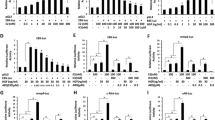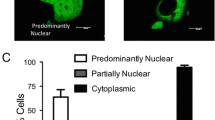Abstract
Objective
It has been shown that LRP16 is an estrogen-induced gene through its recepto rα(ERα). Although there is evidence demonstrating that inhibition of LRP16 gene expression in MCF-7 human breast cancer cells partially attenuates its estrogen-responsiveness, the underlying molecular mechanism is still unclear. Here, the effect of LRP16 expression on the ERα signaling transduction was investigated.
Methods
Cotransfection assays were used to measure the effect of LRP16 on ERα-mediated transcriptional activity. GST-pulldown and immunoprecipitation (CoIP) assays were employed to investigate the physical interaction of LRP16 and ERα. The mammalian two-hybrid method was used to map the functional interaction region.
Results
The results of cotransfection assays demonstrated that the transcriptional activities of ERα were enhanced in a LRP16 dose-dependent manner in MCF-7 in the presence of estrogen, however, it was abolished in the absence of E2 in MCF-7 cells. The physical interaction of LRP16 and ERα proteins was confirmed by GST-pulldown in vitro and CoIP in vivo assays, which was enhanced by E2 but not dependent on its presence. Furthermore, the results of the mammalian two-hybrid assays indicated that the binding region of ERα to LRP16 located at the A/B AF-1 functional domain and E2 stimulated the binding of LRP16 to the full-length ERα molecule but not to the A/B region alone.
Conclusion
These results support a role for estrogenically regulated LRP16 as an ERα coactivator, providing a positive feedback regulatory loop for ERα signal transduction. Based on this function of LRP16, we propose that ERα-positive breast cancer patients with high expression of LRP16 might benefit from targeting LRP16 therapy.
Similar content being viewed by others
References
Prall OW, Rogan EM, Sutherland RL. Estrogen regulation of cell cycle progression in breast cancer cells[J]. J Steroid Biuochem Mol Biol 1998; 65: 169–174.
Planas-Silva MD, Weinberg RA. Estrogen-dependent cyclin E-cdk2 activation through p21 redistribution[J]. Mol Cell Biol 1997; 17: 4059–4069.
McDonnell DP, Norris JD. Connections and regulation of the human estrogen receptor[J]. Science 2002; 296: 1642–1644.
Allred DC, Mohsin SK, Fuqua SA. Histological and biological evolution of human premalignant breast disease[J]. Endoc-Relat Cancer 2001; 8: 47–61.
Deroo BJ, Korach KS. Estrogen receptor and human disease[J]. J Clin Invest 2006; 116: 561–570.
Julie M, Hall JM, McDonnell DP. Coregulators in nuclear estrogen receptor action: from concept to therapeutic targeting[J]. Mol Interv 2005; 5: 343–357.
Shao WL, Brown M. advances in estrogen receptor biology: prospects for improvements in targeted breast cancer therapy[J].Breast Cancer Res 2004; 6: 39–52.
Han WD, Mu YM, Lu XC, et al. Up-regulation of LRP16 mRNA by 17β-estrodial through activation of estrogen α(ERα), but not ERβ, and promotion of human breast cancer MCF-7 cell proliferation: a preliminary report[J]. Endocr Relat Cancer 2003; 10: 217–224.
Han WD, Zhao YL, LI Q, et al. Inhibition of cell proliferation by small interference RNA against LRP16 gene in human breast cancer MCF-7 cells[J]. Chin J Cancer Res 2004; 16: 239–245.
Liao DX, Han WD, Zhao YL, et al. The expression and clinical significance of LRP16 gene in human breast cancer[J]. Chin J Cancer(in Chin) 2006; 25: 866–870.
Zhao YL, Han WD, LI Q, et al. Mechanism of transcriptional regulation of LRP16 gene expression by 17-β estradiol in MCF-7 human breast cancer cells[J]. J Mol Endocr 2005; 34: 77–89.
Finkel T, Duc J, Fearon ER, et al. Detection and modulation in vivo of helix-loop-helix proteinprotein interactions[J]. J Biol Chem 1993; 268: 5–8.
Shi Y, Downes M, Xie W, et al. Sharp, an inducible cofactor that integrates nuclear receptor repression and activation[J]. Genes Dev 2001; 15: 1140–1151.
Lauritsen KJ, List HJ, Reiter R, et al. a role of TGF-beta in estrogen and retinoid mediated regulation of the nuclear receptor coactivator AIB1 in MCF-7 breast cancer cells[J]. Oncogene 2002; 21: 7147–7155.
Fujita T, Kobayashi Y, Wada O, et al. full activation of estrogen receptor α activation function-1 induces proliferation of breast cancer cells[J]. J Biol Chem 2003; 278:26704–26714.
Author information
Authors and Affiliations
Corresponding author
Additional information
This project was supported by the National Natural Science Foundation of China (No. 30670809) and PLA National Science Fund for Distinguished Young Scholars Grant (No. 06J017).
Rights and permissions
About this article
Cite this article
Han, Wd., Zhao, Yl., Wu, Zq. et al. Estrogen receptor α(ERα) target gene LRP16 interacts with ERα and enhances receptor’s transcriptional activity. Chin. J. Cancer Res. 19, 233–237 (2007). https://doi.org/10.1007/s11670-007-0233-z
Received:
Accepted:
Issue Date:
DOI: https://doi.org/10.1007/s11670-007-0233-z




